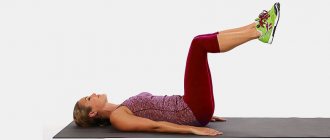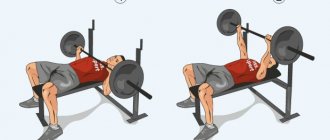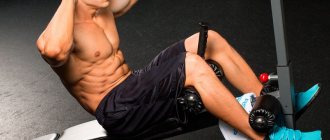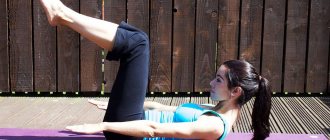The benefits and disadvantages of crunches on the upper block
- The prayer exercise, due to its wide amplitude, allows you to work out the abdominal muscles with great efficiency.
- Develops stabilizer muscles.
- Thanks to the weight plates of the block, the athlete can change the load over a wide range.
- This exercise is considered safe, so it can be included in the training process even for those people who have problems with the spine, but such people must consult a doctor before training.
If there are no contraindications to performing the prayer, and the execution technique is not violated, the exercise is absolutely harmless to the athlete’s health. Of course, you don’t need to use a lot of weight without warming up, even at the beginning of your sports journey.
Follow the correct trajectory. Contraindications to performing this exercise may include diseases of the spine and abdominal organs.
When and how to start training?
There is an opinion among people that there is and cannot be anything better than morning training on an empty stomach, but there is a refutation to this. The fact is that in the morning your glycemic index is close to the minimum mark, so your strength and energy are not in the best condition. In this regard, please note the following:
- Before actual abdominal training, a warm-up is required. For example, dance aerobics (belly dancing, oriental dancing is relevant), stretching or mini-cardio warm-up to ensure that the body is ready for further exercise.
- You can and should exercise in the morning, but doing “passive” exercises, preferably stretching, yoga or Pilates, will be your best contribution to the start of a new day.
- After completing the exercises, you need to provide yourself with protein (chicken breast, cottage cheese) and porridge (oatmeal), you can supplement it with fruits and a spoonful of honey.
Most often, there is enough time in the evening, so come home from work, have a healthy light dinner, and after an hour and a half you can begin warming up and strength exercises on the upper abs.
What muscles work
During prayer, the rectus abdominis muscle works, but its upper part receives the main load. During the prayer exercise, the following muscles receive load:
- Rectus abdominis muscle.
- Back extensor and lumbar muscles.
Specifics of upper abdominal training
The peculiarity of training the upper abs, as already mentioned, is that it is easy to pump them up. Although this often causes problems. For example, you train for a long time, but you only get 4 cubes under the ribs. Yes, this is the result, but it will not look very organic. All you need to do is know when to rush and when not to. Mountain climber is an exercise that will help you lose weight. By doing it slowly, you will stretch your abdominal muscles, which is very beneficial. Well, if it’s quick, then you already understood – burning calories. The same situation with a bicycle. Anyone can train their upper abs: women, men, and children. There are no gender or age specificities there.
In other cases, it is recommended to monitor the pace and, most importantly, the technique. You are pumping up your upper abs, and not passing the standards. If you neglect all this, the result will not please you. As for the result: in a month you will already begin to be proud of yourself if you don’t skip workouts and don’t start eating all sorts of dirty tricks that will harm your figure.
Immediately forget about alcohol, it will not bring any benefit, but will only give you disappointment.
Technique for performing the prayer exercise while sitting on your knees
The exercise is performed as follows:
- The athlete takes a position on the block on his knees. In his hands is a handle-rope.
- As you exhale, tilt (twist the body). The movement is carried out by contracting the abdominal muscles. The head drops to the floor.
- While inhaling, the athlete slowly and concentratedly returns to the starting position, leaving the muscles tense.
- Brushes can be held at the forehead or behind the head, whichever is more convenient. By the way, your hands should remain motionless while performing the movement. Otherwise, if your arms help, there is a chance that the biceps and latissimus dorsi muscles will be involved.
- For greater comfort and relief of discomfort, you can place a mat or towel under your knees.
- When performing the prayer exercise, the athlete should concentrate exclusively on the abdominal muscles. During movement, you need to twist your body and round your back, and not just lower your body down.
Ab swing theory
The main condition for all abdominal exercises is the correct technique, otherwise instead of pumped-up abs you will get discomfort, and possibly even severe back pain. To pump up the lower part of the abs (as well as the upper part), you need to distribute your breathing correctly: all exercises are performed while exhaling, and while inhaling, you should relax the muscles.
Lower back pain can occur even when doing the exercises absolutely correctly: if the pain is not too severe, it can disappear completely when the abdominal muscles become stronger and accumulate strength. However, if the pain continues for more than a few days, you should not do the exercises - you should consult a doctor to identify problems in the lumbar back.
You should not use an overly complex set of workouts - just choose a few of the most effective and simple exercises for different abdominal muscle groups. There is also no need to perform too many approaches: to start, you can perform 3 sets of 15-20 repetitions of one exercise.
Technique for performing the standing prayer exercise
Technically, this option is not much different from the previous one. So the twisting process is identical, however, this exercise is performed while standing.
- Keep your legs slightly bent and place your feet shoulder-width apart.
- Twisting is performed approximately horizontally.
- When returned, the body does not fully straighten. The abdominal muscles are held in tension.
- During the downward movement, exhale while exerting effort, and inhale when returning.
Implementation recommendations
Since the prayer exercise emphasizes the load on the upper abdominals, it is worth including at least one more exercise for the lower abdominals in the training process, for example, leg raises while lying on your back, on an incline bench, on a stability ball, or while hanging.
- To increase muscle volume, you should choose the following training scheme: 3-4 sets of 8-12 repetitions.
- To reduce weight, the number of repetitions can be increased to 25. This option is suitable for women's training.
You shouldn’t start right away with the working weight. Never ignore a warm-up hike with minimal weights.
Top 3 lower abdominal exercises for home and gym
To pump up the lower abs, movements are used in which the legs are brought towards the body. Bringing your torso toward your legs will engage your upper body more.
Exercise "book"
This is a universal lower abdominal exercise for men and women. It is incredibly effective and is considered complex, as it actively loads the lower and upper parts. To shift the emphasis of execution to the lower part, the “book” is performed while sitting on a bench or chair. To do this, the body leans back slightly, and the legs move from the floor to the body (you cannot put your feet on the floor between repetitions).
Lying leg raise
The most popular movement to pump up your lower abdominal muscles. However, very often the lift is performed incorrectly, this puts the lower back under stress and switches the load from the abs to other muscles. Important Features:
The lower back and buttocks should not hang. If you do it in the gym, your buttocks are on the edge of the bench. When performing lower abdominal exercises at home, it is better to sit on the floor, this will allow you to place the correct emphasis on your back and buttocks. Do not place your feet on the floor, this will weaken the load
Regardless of where the lower abdominal exercise is performed, it is important to maintain tension until the end of the set. Legs should be raised strictly to the level when a right angle is formed between the body and hips
Many athletes, in pursuit of pumping up their lower abs, try to raise their legs as high as possible, right up to forehead level. This will only reduce the load from the lower abs and switch it to the lower back.
Hanging Leg Raise
An incredibly useful movement if done correctly. If you have a horizontal bar, it’s perfect for pumping up your lower abs at home.
When performing, you should pay attention to the technical features:
- Avoid swaying completely (from your arms to your buttocks, your body should hang motionless, only the lower part of the body moves).
- You should not raise your straightened legs forward. This does not provide any advantage, but it shifts almost all the load to the hips and buttocks. To properly pump your lower abs, optimally raise your bent legs at the knees.
- The movement is performed slowly and under control, with a delay of 1-2 seconds at the top point.
How to replace the exercise
You can replace the exercise with crunches on a fitball, straight crunches on the floor, or crunches on an incline bench.
There is also another good option for crunches that can replace this exercise in the gym: crunches with an upper block using an incline bench . When performing this exercise, the athlete takes a place on a bench, sitting with his back to the machine. Technically, everything is simple - the movements are identical to any twisting with weights behind the back.
A little more about classes
Basic exercises should be enough to achieve good results, provided they are performed well, of course. At the same time, there are a number of other, additional exercises that will be useful if you want to pump up your abs:
- try simply lifting your upper body. To do this, lie down on the mat, bend your knees at a right angle and start lifting. During the exercise, the upper abs should be in an extremely tense state. At the same time, you need to pull your hands forward. Having raised your torso to the top point, you need to try to maintain this position (aim for a 10-second hold);
- Alternative option: when performing the exercise, clasp your hands behind your head;
- Another option: the same actions, but arms crossed on the chest;
- Sit on a bench (any other object that allows you to bend) and begin to bend. You should pause halfway through the fold (the longer, the better).











